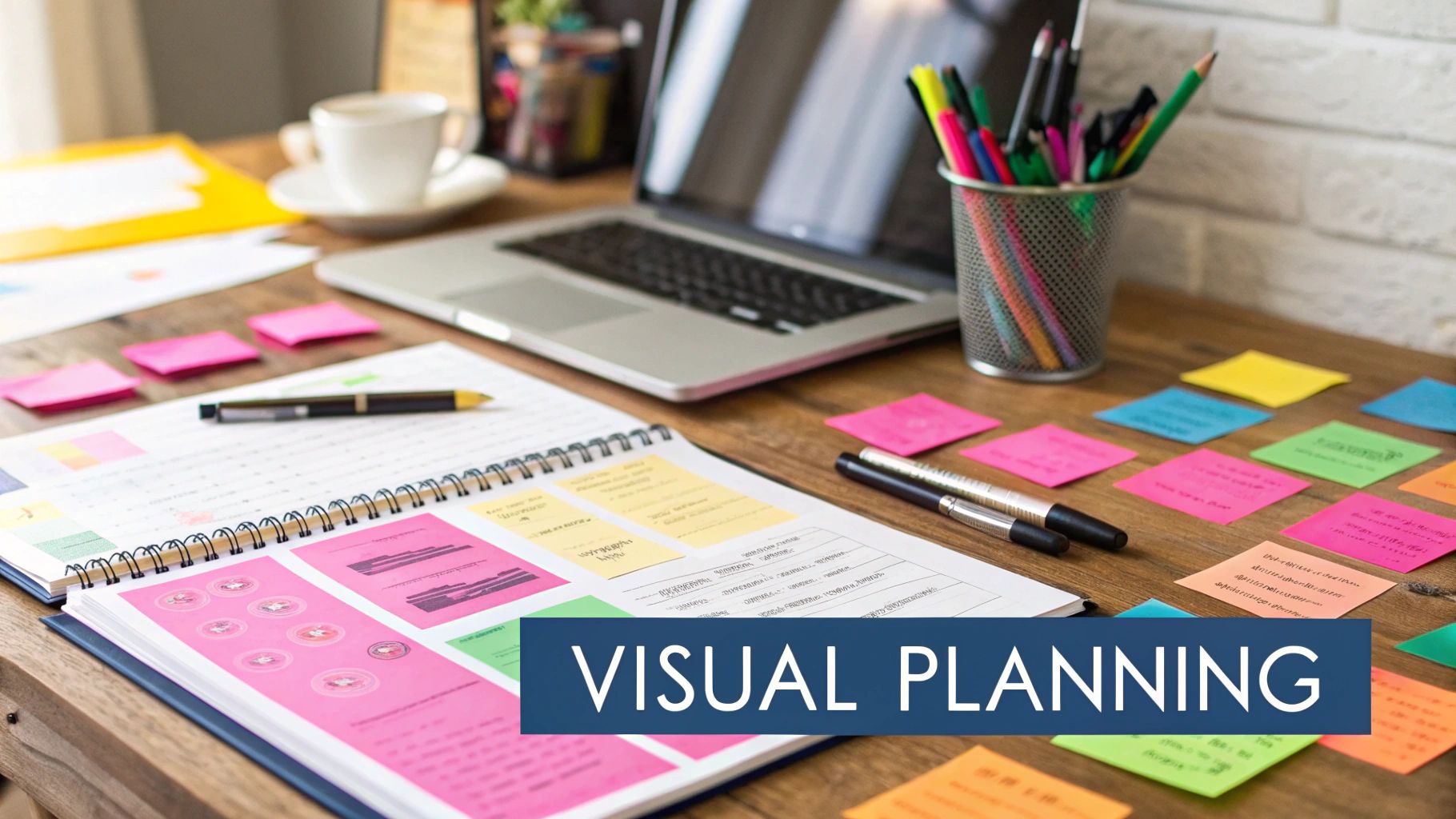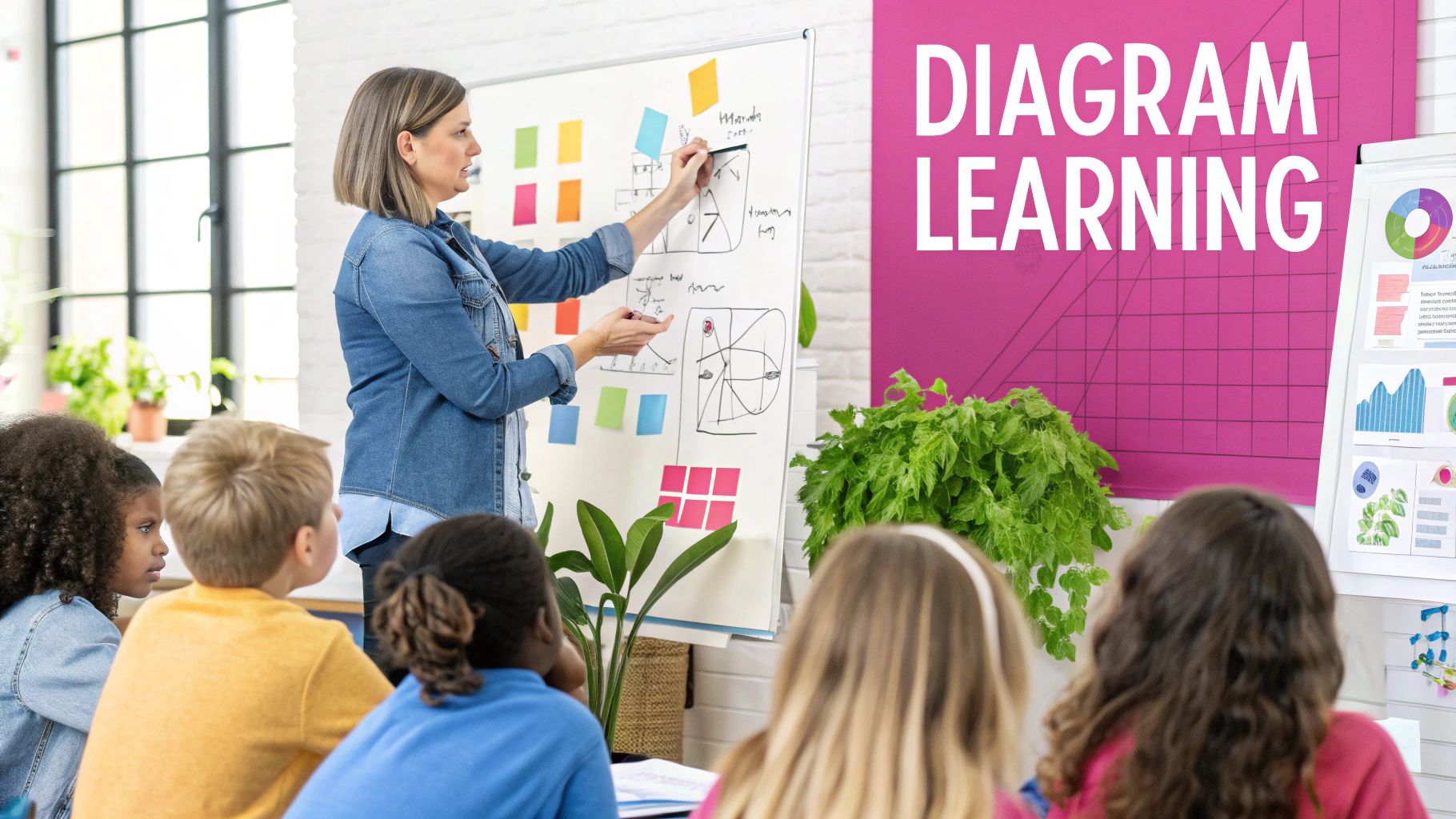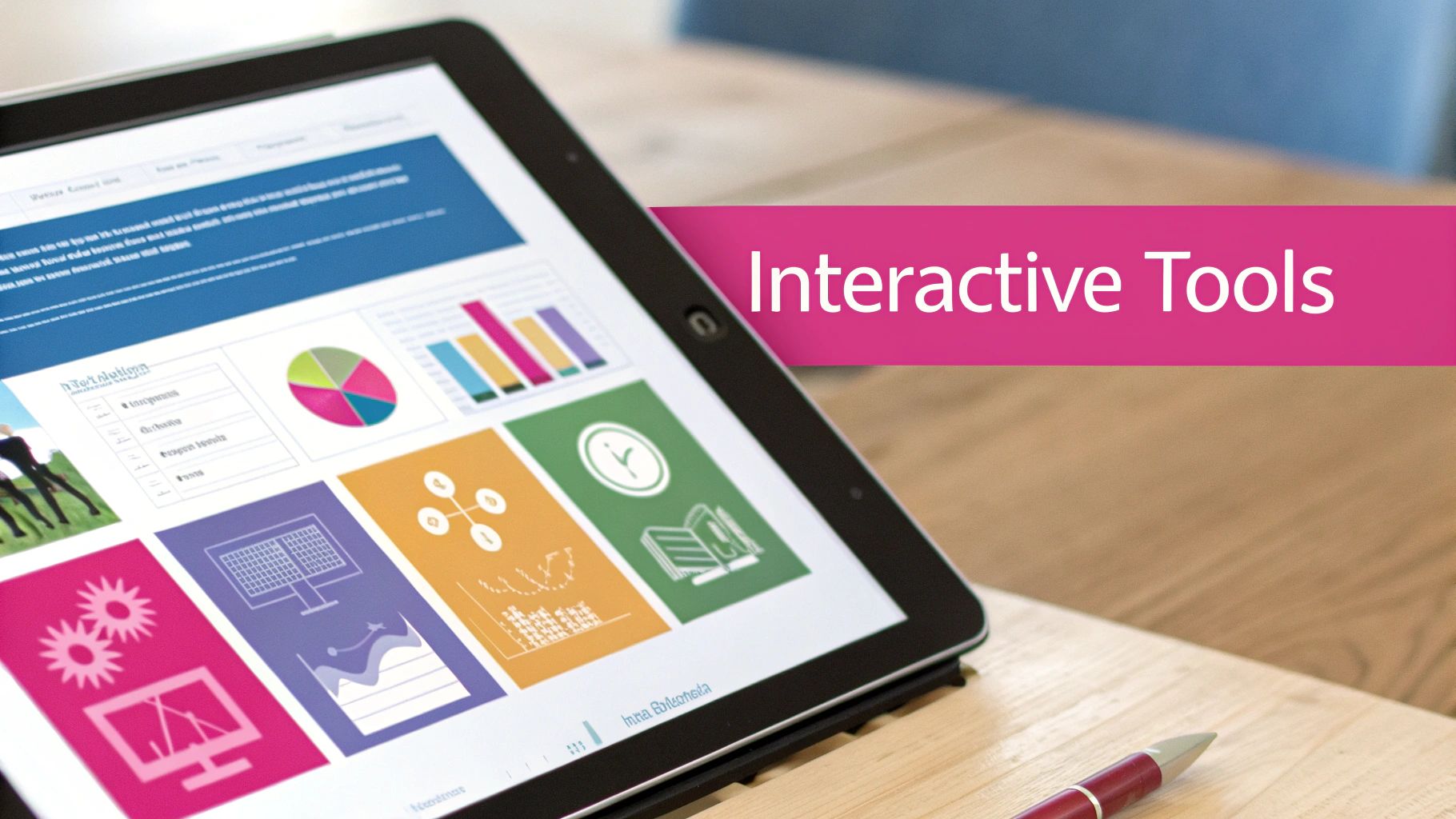
Proven Study Methods for Visual Learners: Your Complete Guide to Academic Excellence
Understanding the Science of Visual Learning Success

Visual learning goes far beyond simply preferring images over text. When you understand how your brain processes visual information, you can tap into powerful ways to boost your learning and memory. For visual learners especially, images and diagrams serve as strong memory anchors that significantly improve both understanding and recall.
How the Brain Processes Visual Information
Your brain has specialized pathways dedicated to processing visual information that work much faster than those handling text. Think about how quickly you can recognize a friend's face or grasp what's happening in a scene – this rapid processing makes visual input particularly memorable. When you watch a well-designed educational video, like those from Notescast, multiple senses engage simultaneously to strengthen memory formation.
Consider learning complex topics like the Krebs cycle in biology. Reading a detailed text description of the chemical reactions can feel overwhelming. However, watching an animated video that shows each step with clear labels makes the process much easier to grasp. The visual format helps break down complicated concepts into digestible pieces.
Visual learning also enables you to create mental maps and connections between ideas. For example, when studying government structure, a mind map showing the relationships between different branches helps you understand the big picture better than memorizing a list. These visual connections make it easier to link new information to what you already know.
One of the most striking benefits is how dramatically visuals boost memory retention. Research shows our brains process visual information 60,000 times faster than text alone. Learn more about visual learning statistics. This highlights why incorporating visual study methods is so important for academic success. By using visual learning techniques strategically, students can fight against normal forgetting curves and retain information more effectively long-term.
Mastering Essential Tools for Visual Study Success

Visual learning offers a powerful way to absorb and retain information. To make the most of this approach, you'll need the right set of tools and techniques. Let's explore how to move beyond basic highlighting to create engaging visual study materials that truly work for your learning style.
From Highlighting to Dynamic Visuals
While highlighting text can be useful, effective visual learning requires more active engagement. Instead of simply marking up text, try creating your own visual representations of key concepts. For instance, design flashcards that combine images with text to illustrate important ideas. You can also develop a color-coding system to organize different types of information, making it easier for your brain to process and recall later.
Choosing the Right Visual Aids
Just as different tasks require different tools, visual learners need various methods to study effectively. Here are some proven tools to help you succeed:
- Mind Maps: Perfect for connecting ideas and showing relationships. Start with your main topic in the center and draw branches to related concepts.
- Graphic Organizers: Use Venn diagrams and flowcharts to break down complex topics into clear, visual formats.
- Sketchnoting: Combine simple drawings with key phrases to create memorable visual summaries of your lessons.
- Digital Tools: Apps like Notescast can help turn text into engaging videos, adding sound to reinforce visual learning. Many teachers now use visual presentations and infographics to help students grasp complex topics more easily. Learn more about visual learning techniques at Potomac University's resource center.
Practical Strategies for Visual Study Guides
Creating effective visual study materials is a skill that can significantly boost your academic performance. Here's a step-by-step approach to get started:
- Identify Key Concepts: Before creating visuals, determine the most important information from your materials.
- Choose the Right Format: Match your visual tool to the content – use mind maps for brainstorming or flowcharts for processes.
- Use Color Strategically: Develop a consistent color system to organize different types of information.
- Keep it Concise: Focus on essential information using keywords and simple images rather than long text blocks.
- Review Regularly: Make time to review your visual study guides often to strengthen your understanding.
By applying these tools and techniques consistently, you can make your study sessions more productive and memorable. Remember that visual learning isn't just about preference – it's an effective strategy that can help you better understand and remember what you learn.
Creating Visual Study Systems That Actually Work
Visual learners excel when they can convert abstract concepts into clear images and diagrams. Let's explore practical ways to build study systems that make the most of this natural learning style.
Developing Effective Visual Summaries
Good visual summaries do more than just add color to your notes – they help you process and retain information more effectively. Rather than simply reading textbook chapters over and over, try actively creating visual representations of key ideas. For example, when studying biology, sketch out detailed diagrams showing processes like photosynthesis or cell division. This active engagement helps cement concepts in your memory.
Mind maps are another powerful visual tool. Place your main topic in the center of the page and draw branches to connect related subtopics and details. Include keywords and small drawings to reinforce the connections. This gives you a clear overview of how different concepts fit together.
Implementing Strategic Color-Coding
A thoughtful color-coding system makes your notes easier to navigate and remember. Pick specific colors for different types of information – for instance:
- Blue for key definitions
- Green for examples and applications
- Red for important formulas or dates
This creates clear visual patterns that help you quickly find what you need. Many digital note-taking apps also let you add searchable color tags to further organize your materials.
Creating Memorable Visual Mnemonics
Visual memory tools transform abstract ideas into memorable images. For example, to remember the planets in order from the sun, you might picture Mercury as a tiny thermometer (since it's closest to the sun's heat), Venus as a cloudy crystal ball, Earth as a blue marble, and so on. The more creative and unique your mental images, the better they'll stick in your memory.
Organizing Visual Study Materials and Managing Revisions
Good organization is essential for visual learners. Use folders, binders or digital tools to sort your diagrams, mind maps and other visual notes into clear categories. This prevents visual overload and helps you quickly access what you need.
Regular review strengthens your grasp of the material. Schedule time to actively work with your visual study aids – redraw key diagrams, explain concepts out loud, or quiz yourself. This active engagement is key. Research shows that visual learning can improve comprehension by up to 400% because our brains process images much faster than text. Learn more about the power of visual learning. By building these visual study habits, you'll make your learning more effective and engaging.
Harnessing Technology for Visual Learning Excellence

Smart use of technology can make a huge difference for visual learners. The right digital tools can help you process and retain information more effectively through images, videos, diagrams and other visual formats. Let's explore how to build a personalized set of digital learning tools that match your needs.
Choosing the Right Digital Tools
The best tools for you will depend on how you learn best. For instance, some students thrive with interactive videos that combine visuals and audio explanations. Others find mind mapping tools essential for organizing complex topics visually. Notescast is a good example – it converts text notes into short, engaging videos that make dense material easier to understand.
Here are some key digital tools that work well for visual learners:
- Interactive Video Platforms: Engage with animated video lessons that explain concepts visually
- Mind-Mapping Software: Create visual diagrams to connect ideas and see relationships
- Digital Flashcard Apps: Review image-based flashcards for better memorization
- Visual Note-Taking Apps: Add images, diagrams and color-coding to your notes
Creating a Powerful Visual Learning Ecosystem
Different tools work better together. For example, you might map out an essay structure visually, then make flashcards to memorize key points, and finally watch a video to understand tricky concepts. This combined approach helps reinforce learning in multiple ways.
Visual learning analytics (VLA) adds another helpful dimension by providing data-driven insights about how students learn visually. Teachers can use this information to better support individual learning needs. Learn more about VLA research here: Visual Learning Analytics Research
Exploring Free and Premium Options
Many excellent visual learning tools are available for free. Premium versions often include extras like advanced customization and collaboration features. Think about which specific capabilities you need most when deciding what's worth paying for.
Avoiding Technology Pitfalls
While digital tools are valuable, it's important to use them wisely. Don't rely solely on technology – combine it with traditional methods like drawing diagrams by hand or writing summaries. Take regular screen breaks to prevent eye strain and stay focused. When used thoughtfully, technology can significantly improve how you learn visually.
Advanced Visual Learning Strategies for Modern Students

Visual learning remains one of the most effective ways to master new material. Building on fundamental visual learning principles, students can now use proven techniques backed by research and modern tools to achieve better results. The concept traces back to the early 1900s with the introduction of the VAK (Visual, Auditory, Kinesthetic) learning model. While experts now recognize learning involves multiple styles, visual methods continue to show strong results in helping students grasp and retain information. For more insight into the impact of visual learning, check out these detailed visual learning statistics.
Visual Storytelling for Complex Concepts
Breaking down difficult topics into visual stories makes them easier to understand and remember. This approach works especially well for step-by-step processes or complex theories. For example, when studying cell division in biology, create a series of simple sketches showing each phase of mitosis with brief notes. This visual sequence helps you follow the process logically and creates stronger memory connections than text alone.
Interactive Visual Note-Taking
Visual notes become more powerful when you make them dynamic and engaging. Use color-coding to group related concepts, draw connecting lines between linked ideas, or add expandable details in digital notes. This active approach to note-taking helps cement information in your memory. Tools like Notescast can enhance your visual notes by turning them into engaging video content.
Multi-Sensory Visual Learning
Adding other senses to visual learning creates stronger mental connections. Try recording yourself explaining a concept while drawing it out, or pair diagrams with audio explanations. When you combine visual elements with sound or movement, you create multiple pathways in your brain to access that information later.
Visual Practice Testing and Retrieval
Test your knowledge using visual methods to reinforce learning. Create flashcards that include diagrams, charts, or other visual elements alongside questions. Active recall through visual practice is proven to be one of the most effective ways to strengthen memory. Challenge yourself to redraw important diagrams from memory to identify gaps in your understanding. By consistently using these methods, you'll develop stronger learning skills and better academic results.
Real Success Stories and Implementation Strategies
Visual learning isn't just a nice-to-have – it's a proven way to boost academic performance when used effectively. Real students have seen remarkable results by incorporating visual study methods into their routines. Let's explore their stories and learn practical steps to apply these techniques successfully.
From Struggling to Thriving: Case Studies in Visual Learning
Meet Maria, a biology student who found herself lost in dense textbook descriptions of cellular respiration. Traditional reading and lectures weren't clicking for her until she discovered the power of visual learning. By creating detailed, color-coded diagrams showing each step of cellular processes, Maria was able to grasp complex concepts that had previously eluded her. This simple change led to a 15% improvement in her exam scores.
David's story shows similar success in a different field. As a history student, he struggled to keep track of countless dates, names and events – until he started organizing information visually through timelines and mind maps. This approach helped him see connections between historical events more clearly. For David, reviewing his visual study materials before tests not only improved his grades but also reduced his test anxiety significantly.
Implementing Visual Learning: A Step-by-Step Guide
Want to achieve results like Maria and David? Here's how to start using visual learning effectively:
- Identify Your Learning Style: While visual learning is powerful, everyone processes visual information differently. Some prefer detailed diagrams, others respond better to mind maps or video content. Try different formats to find what works best for you.
- Choose the Right Tools: From basic supplies like colored pens and sticky notes to digital tools like Notescast for creating video notes, pick tools that match your preferred learning style.
- Start Small and Be Consistent: Begin with one subject or topic rather than trying to change everything at once. Build confidence gradually and maintain regular practice.
- Track Your Progress: Keep notes on how visual learning affects your understanding and test scores. This helps you stay motivated and fine-tune your approach.
- Adapt and Refine: Be ready to adjust your methods based on what works. Different subjects may need different visual approaches.
Troubleshooting Common Visual Learning Challenges
Even experienced visual learners face obstacles. Here's how to handle common issues:
- Visual Overload: Keep diagrams and mind maps simple and focused. Adding too much detail can be counterproductive.
- Time Management: Set aside specific time for creating visual study materials. The upfront investment pays off in better understanding later.
- Digital Distractions: When using digital tools, close unnecessary browser tabs and turn off notifications to stay focused.
Subject-Specific Strategies and Examples
Each subject benefits from different visual approaches:
| Subject | Visual Strategy | Example |
|---|---|---|
| History | Timelines, Mind Maps | Mapping key events of the French Revolution |
| Science | Diagrams, Flowcharts | Illustrating the process of photosynthesis |
| Mathematics | Graphs, Charts, Visual Problem Solving | Graphing equations to visualize relationships |
| Literature | Character Maps, Storyboards | Visualizing the plot of a novel |
Ready to improve your study habits? Start creating engaging video notes with Notescast today!
